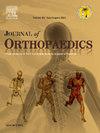关节镜下肩袖修复术后以曲马多为基础的多模式疼痛治疗方案与以羟考酮为基础的治疗方案同样有效,但处方的吗啡毫克当量更少,再次使用的风险更低
IF 1.5
Q3 ORTHOPEDICS
引用次数: 0
摘要
曲马多是一种合成阿片类药物,用于控制术后疼痛,同时减轻强阿片类药物(如羟考酮)的有害影响。然而,尚不清楚曲马多是否可以作为肩部手术后羟考酮的适当替代品。因此,本研究的主要目的是比较关节镜下肩袖修复(ARCR)后接受曲马多和羟考酮的患者术后早期疼痛评分和处方麻醉。次要目的是确定与术后疼痛增加或术后处方增加相关的危险因素。方法采用回顾性队列研究,对58例接受曲马多疼痛治疗方案的患者和103例接受羟考酮治疗方案的患者进行评估。术前、术后2周、6周、3个月分别进行VAS疼痛评分。计算术前至随访3个月VAS评分的变化。记录吗啡总毫克当量(MMEs)的处方量、补药次数和时间,以及曲马多治疗方案失败而需要羟考酮的患者比例。进行多变量回归分析以确定术后疼痛评分较高和需要增加处方数量的危险因素。结果羟考酮组的MMEs平均总处方数是曲马多组的8倍以上(993对120)。两组在所有时间点的疼痛评分均有改善。接受曲马多治疗的患者从术前到术后各时间点的VAS评分变化较大。服用羟考酮的患者比服用曲马多的患者在3个月内再次服用羟考酮的次数更多,需要再次服用的可能性是服用曲马多的2.7倍。只有4例接受曲马多治疗的患者(6.9%)在手术3个月内需要羟考酮。结论作为多模式治疗方案的一部分,与羟考酮相比,曲马多对ARCR后疼痛的缓解效果相当,但需要较少的MMEs,服用羟考酮的患者对VAS疼痛的改善程度较小,需要更多的补药。我们的研究结果可用于改善阿片类药物处方实践,以减少对麻醉品的依赖和过度处方。本文章由计算机程序翻译,如有差异,请以英文原文为准。
Tramadol-based multimodal pain protocols after arthroscopic rotator cuff repair are similarly effective as oxycodone-based protocols with fewer morphine milligram equivalents prescribed and lower risk of refills
Background
Tramadol is a synthetic opioid prescribed to control postoperative pain while mitigating the harmful effects of stronger opioids, such as oxycodone. However, it is unknown whether tramadol can serve as an adequate substitute for oxycodone following shoulder surgery. Therefore, the primary purpose of this study was to compare early postoperative pain scores and prescribed narcotic between patients receiving tramadol and oxycodone after arthroscopic rotator cuff repair (ARCR). The secondary purpose was to identify risk factors related to experiencing increased postoperative pain or requiring increased postoperative prescriptions.
Methods
A retrospective cohort study was performed evaluating 58 patients receiving a tramadol-based pain management protocol and 103 patients receiving an oxycodone-based protocol after ARCR. VAS pain scores were obtained preoperatively and at 2 weeks, 6 weeks, and 3 months postoperatively. The change in VAS score from preoperative to 3-month follow-up was calculated. Total milligram morphine equivalent (MMEs) prescribed, number and timing of refills, and the proportion of patients failing the tramadol protocol who required oxycodone were recorded. Multivariate regression analysis was performed to determine risk factors for having higher postoperative pain scores and requiring an increased number of prescriptions.
Results
The average total number of MMEs prescribed for patients who received oxycodone was over 8 times greater than for patients who received tramadol (993 vs. 120 MMEs). Both groups demonstrated improvements in pain scores at all time points. Patients receiving tramadol had a greater change in VAS score from pre to postoperative at all timepoints. Patients who were prescribed oxycodone received a greater number of refills and were 2.7 times more likely to need a refill within 3 months than those receiving tramadol. Only 4 patients (6.9 %) receiving tramadol required oxycodone within 3 months of surgery.
Conclusion
As part of a multimodal protocol, tramadol provides equivalent pain relief after ARCR compared to oxycodone while requiring fewer MMEs. Patients prescribed oxycodone exhibit a smaller magnitude of improvement in VAS pain and require more refills than those prescribed tramadol. Our findings can be used to improve opioid prescription practices to reduce dependency and over prescription of narcotics.
求助全文
通过发布文献求助,成功后即可免费获取论文全文。
去求助
来源期刊

Journal of orthopaedics
ORTHOPEDICS-
CiteScore
3.50
自引率
6.70%
发文量
202
审稿时长
56 days
期刊介绍:
Journal of Orthopaedics aims to be a leading journal in orthopaedics and contribute towards the improvement of quality of orthopedic health care. The journal publishes original research work and review articles related to different aspects of orthopaedics including Arthroplasty, Arthroscopy, Sports Medicine, Trauma, Spine and Spinal deformities, Pediatric orthopaedics, limb reconstruction procedures, hand surgery, and orthopaedic oncology. It also publishes articles on continuing education, health-related information, case reports and letters to the editor. It is requested to note that the journal has an international readership and all submissions should be aimed at specifying something about the setting in which the work was conducted. Authors must also provide any specific reasons for the research and also provide an elaborate description of the results.
 求助内容:
求助内容: 应助结果提醒方式:
应助结果提醒方式:


